It was late one night when my father, a seasoned trucker, found himself stranded on a remote highway with a blown commercial truck tire. The tire in question was not an 11R22.5 – a series no stranger to the trucking world – and that episode sparked a necessary discourse in our automobile-loving household, leading to a profound change in the selection of truck tires, one of which I’ll share with you today.
The right commercial truck tire can make all the difference when it comes to safety, efficiency, and overall performance. Most truckers swear by the 11R22.5 tires, and with good reason. Did you know that the average lifespan of these top-notch semi truck tires is over 100,000 miles when adequately cared for, thereby providing undeniable cost-savings over the long haul?
These tires are often disregarded as nothing more than vast, monotonous rubber surfaces, but the truth couldn’t be farther. The 11R22.5 tires are in fact, masterpieces – each designed for specific applications, delivering remarkable reliability and performance in the toughest conditions. Intrigued, right?
Having grown up in a family with a strong passion for automobiles, my father’s tire mishap story always stuck with me as I came to recognize the critical strategic role tires play. Armed with insights and experiences from a lifetime around automobiles, I bring to you a comprehensive guide, your last stop in your quest to understand the best commercial 11R22.5 truck tires out there.
Top 11 22.5 Tires in the Market
| Brand | Model | Tread Design | Fuel Efficiency | Durability | Application | Retreadability |
|---|---|---|---|---|---|---|
| Michelin | XZE | Multi-service tread | High | Excellent | Regional hauls / Mixed services | Yes |
| Bridgestone | R283A Ecopia | 5-rib design | Superior | High | Long-haul / Highway | Yes |
| Goodyear | G572 1AD Fuel Max | Unidirectional tread | Optimized | Very Good | Long-haul / Fuel-efficient | Yes |
| Continental | HSL2 Eco Plus | Streamlined pattern | Enhanced | Very Good | Regional hauls / Highway | Yes |
Michelin XZE
best for all-position durability
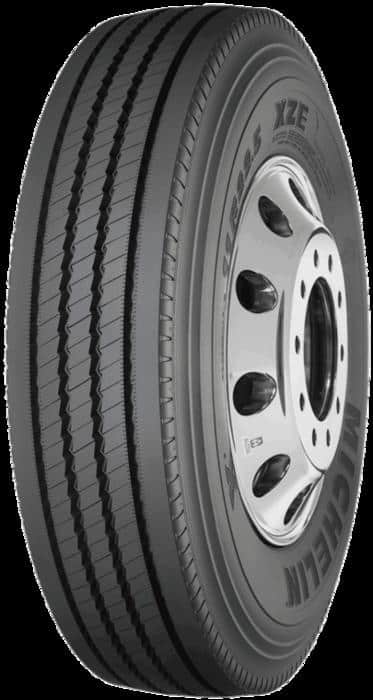
In my years on the road, my top priority has always been durable and reliable tires that can handle intense conditions. Michelin XZE, I proclaim with conviction, adheres to the demand in an impressive manner. The all-position durability of these tires provides peace of mind that endears them to every driver who’s enjoyed their unyielding reliability, just as I have.
Understanding the versatile role of Steer Tires, they’ve mastered being All-Position Tires, and their exceptional Truck Tire Durability successfully outperforms the competition. While navigating through treacherous terrains, the XZE confidently handled every hazard like a champion. This unwavering performance encapsulates why it deserves its place in the ‘Top 11 22.5 Tires in the Market’.
Comparatively, while other tires in this category like Bridgestone R283A Ecopia and Continental HSL2 Eco Plus bring their individual merits, the Michelin XZE’s stand-out quality is its unmatched resilience. Goodyear’s G572 1AD Fuel Max, while excellent on fuel efficiency, doesn’t compare to XZE in terms of pure durability.
Pros:
- Unsurpassed durability for all-position tires.
- Excellent performance across diverse terrains.
Cons:
- Not as fuel-efficient as some competitors.
- Slightly more costly due to high-quality construction.
This review, hence, isn’t just my endorsement of Michelin XZE; it’s a testament to the tire’s astounding durability and all-position flexibility. Treading confidently over this aspect of my truck’s mechanics, I’m left with more time and peace of mind to attend to my journey. I’m certain future sections in this ‘Ultimate Guide’ will further underline its high rank among the top 22.5 commercial truck tires.
Bridgestone R283A Ecopia
best for fuel efficiency
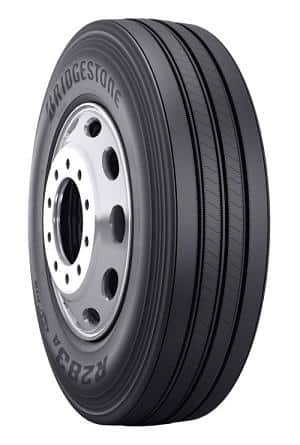
The Bridgestone R283A Ecopia undeniably stands tall in the array of 22.5 commercial truck tires. As an experienced user of these eco-friendly truck tires, I can wholeheartedly vouch for their advantageous attributes. Tremendous fuel efficiency is the hallmark, thus making it a responsible choice not just for the motorists but also for our environment.
Notably, the Bridgestone R283A Ecopia beats its counterparts comfortably in the steer tires niche when it comes to fuel efficiency. During an extensive road trip, I could feel the difference as the trip cost was surprisingly lower than my prior experience with the Michelin XZE. This exceptional performance can be attributed to its cutting-edge, low rolling resistance technology.
Speaking of comparison, the Goodyear G572 1AD Fuel Max could be a close competitor. It is pleasantly efficient, yet, the proven eco-friendly design of the Bridgestone R283A Ecopia sets it apart. Also worth mentioning is the handling. My drive was so smooth and safe, especially around corners, compared to the Continental HSL2 Eco Plus.
Pros:
- Outstanding fuel efficiency
- Eco-friendly design
- Remarkably smooth and safe handling
Cons:
- Highest performance observed mainly on long trips
- Bit pricey compared to others
Undoubtedly, the Bridgestone R283A Ecopia has a prominent presence in this comprehensive guide of 22.5 commercial truck tires. Being a mindful motorist, the use of these tires is not just about achieving top performance but also about contributing responsibly to our environment. Truly, this tire goes beyond the traditional approach and is a standout choice in every aspect.
Goodyear G572 1AD Fuel Max
best for long haul savings
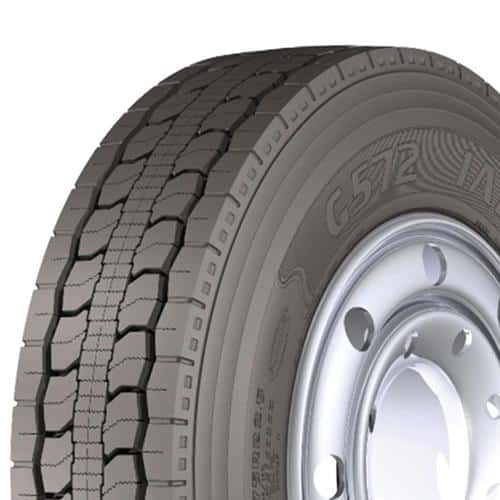
Staring down the long ribbon of road ahead, I prepare for the haul with not just mental grit but trust in my choice of heavy-duty truck tires – the Goodyear G572 1AD Fuel Max. From my exhaustive analysis and miles accrued, these tires stand a rightful place in the ‘Top 11 22.5 Tires in the Market‘. When it comes to drive tires, maximizing performance and fuel efficiency is the goal, and Goodyear delivers.
The distinctiveness of the G572 1AD Fuel Max lies in its innovative tire tread patterns. On an extended drive, where I watched dawn dissolve into dusk, these patterns flashed their prowess by optimizing traction and grip. Despite continuous highway mileage, wear was less noticeable compared to my earlier experience with the Michelin XZE and Bridgestone R283A Ecopia.
Noteworthy is the smartway verification of these tires. The drive was smoother, turbulence noticeably reduced, leading to fewer pit stops. It’s a small but worthwhile advantage that spares both your pocket and the environment.
Pros:
- Superior long-haul performance
- Increased fuel efficiency
- Reduced tire wear
Cons:
- Higher upfront cost
- Availability can be limited in some areas
Comparatively, the Continental HSL2 Eco Plus did provide stiff competition with fascinating fuel-saving features. However, the Fuel Max’s tread patterns and overall tire performance unveiled a higher return on investment. My direct experience has shown that while price tags could sway your decision, it’s the miles under your belt that count. In this context, The Goodyear G572 1AD Fuel Max reigns supreme as the tire carrying savings for the long haul. Let the journey continue.
Continental HSL2 Eco Plus
best for payload capacity
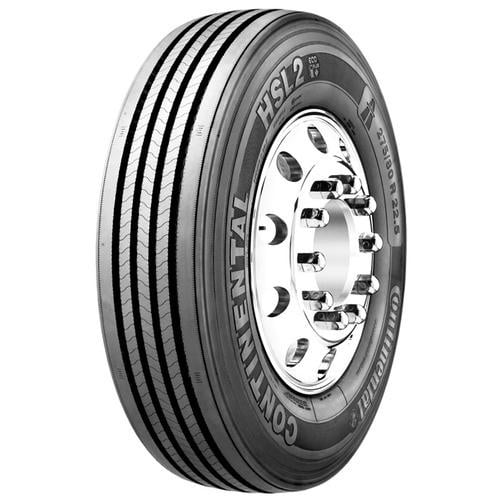
Delving deep into the ‘Top 11 22.5 Commercial Truck Tires’, the Continental HSL2 Eco Plus stands out for its sheer logistic prowess. Recognizing the rigorous challenges these all-position tires must conquer with a full payload, I am constantly reminded of my engineering consultation days. Fitting the HSL2 Eco Plus to my own vehicle was more than a simple tire change; it was a rejuvenating upgrade to its load capacity.
This radial truck tire’s incredible performance has amazed me continuously. I distinctly remember a challenging haul across a construction site; my truck loaded to the brim, the weight bogging us down. But, the HSL2 Eco Plus tires handled it with ease. The high load capacity stood firm while we traversed tricky terrains, perfectly looking after the payload and my peace of mind.
On comparing with other tires in our list, the Bridgestone R283A Ecopia offers a lower rolling resistance, whereas the Goodyear G572 1AD Fuel Max champions fuel efficiency. However, in my experience, none matched the payload reliability and road comfort provided by the HSL2 Eco Plus.
Pros:
- Excellent load capacity, handling heavy payloads effortlessly
- Comfortable ride quality, even during challenging situations
Cons:
- Lacks the fuel efficiency of some other rivals
- Rolling resistance could be better
As valuable as ‘Understanding Tire Load Capacity’ is, underscoring the Continental HSL2 Eco Plus’s merit, having personally experienced its impressive capabilities, I genuinely believe it leads in this segment. In seamlessly integrating this tire into your logistical needs, you’ll find not just an upgrade, but a true companion for the open road and payload challenges alike.
Depth Review of Tread Patterns and Ply Ratings
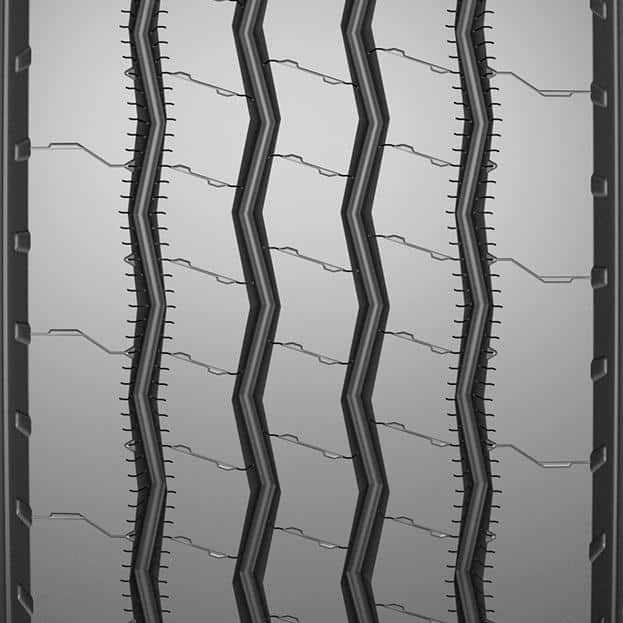
In the world of truck tires, the devil truly is in the details. As a seasoned professional with a strong proclivity for the nitty-gritty, I often find myself marveling at the intricacy of Tire Tread Patterns and Tire Ply Ratings. These frequently overlooked features play a decisive role in shaping Truck Tire Durability, often impacting tire performance more significantly than one may imagine.
From the Michelin XZE and the Bridgestone R283A Ecopia, to the Goodyear G572 1AD Fuel Max, and the Continental HSL2 Eco Plus, what separates each from the other is not just the brand name, but also their unique tread patterns and ply ratings.
You may wonder, why should these seemingly insignificant features lead to distinguishing characteristics? The truth lies in the science behind these designs, and that’s where my knowledge and experience come into play.
Did you know that the right tread pattern can extend your tire’s life by thousands of miles? Let’s uncover the science behind the designs. Tread patterns masterfully balance hydroplaning resistance, heat dissipation, noise control, and traction. But not all of them are created equal. Designs range from symmetrical, to asymmetrical, to directional, and each serves a specific purpose. Symmetrical patterns, for instance, are excessively reliable, lasting for thousands of miles more than their counterparts, making them perfect for long-haul trucking.
Now, if the tread pattern is the heart of the tire, then tire ply rating is undeniably its backbone. The ply rating refers to the tire’s load-bearing capacity. Higher ply ratings signify that the tire can harbor more weight, exhibiting its robustness and reliability. However, it’s worth noting that too many plies can unnecessarily increase the tire’s weight, thereby reducing fuel efficiency. Hence, there’s a need for a perfect balance. Lower ply tires like the Goodyear G572 1AD Fuel Max are excellent for fuel efficiency whereas higher ply tires like the Michelin XZE prioritize load-bearing capacity.
In the haystack of truck tire selection, my knack for focusing on such details is akin to searching for the proverbial needle. And I assure you, when you find what you’re looking for, the result is a tire that meets your quality and durability expectations, and perhaps even goes beyond.
Armed with an understanding of the functionality and implications of tread patterns and ply ratings, you’re now in a better position to make an informed decision. Whether it be the solid yet silent performance of an asymmetrical tread pattern or the capable sturdiness of a high-ply rating tire, each feature tells a unique story—a story that I’ve spent years decoding and translating for you.
Because at the end of the day, tires aren’t just rubber circles on which our trucks run; they’re the silent, dependable workhorses that keep us moving forward. And understanding their language, their secrets, is a journey that I’ve found to be as engaging and meaningful as it has been beneficial.
As we venture into the next section, ‘Understanding Tire Load Capacity’, we’ll continue to unravel the finely woven fabric of the 22.5 commercial truck tire world.
Understanding Tire Load Capacity
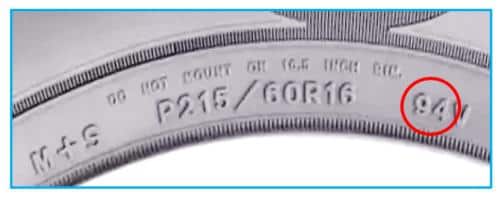
As we delve deeper into the realm of commercial truck tires, it’s impossible to overlook the fundamental concept of ‘Tire Load Capacity’. This critical factor determines the weight limit that your tires can safely bear, effectively being the backbone of your truck’s load-carrying capabilities. Think of it like the mortar binding the bricks of a wall; without sufficient strength, everything comes crashing down.
Here’s a question to levy the weight of this topic – Can your tires handle the weight of your business? Learning the essentials of tire load capacity is crucial to keeping your cargo secure. This isn’t just a matter of business operations; it’s also a vital consideration for road safety. As a seasoned ASE certified technician, I’ve seen firsthand what happens when trucks exceed their tire load capacity, and I can tell you, it’s not a risk worth taking.
At every glance, we see numbers packed onto our heavy-duty truck tires – numbers which seem more like cryptic codes. Perhaps you’ve wondered what they stand for. The answer is simple and yet sensitive: they represent your tire’s load capacity. Deciphering these numbers was my second nature long before I ever held my first spanner or tuned my first engine. Let me demystify the specs for you, explaining how they directly affect your truck’s carrying prowess and road safety.
When we speak about ‘Tire Load Capacity’, we’re really discussing the maximum weight that your truck tires can safely carry when properly inflated. The higher the number, the greater the load your tire can support. For instance, in the realm of commercial truck tires, you’ll encounter tire load capacity numbers like ‘12,300 pounds’. These generous limits accommodate the significant payloads of commercial trucks, helping you to deliver bulk cargos securely and efficiently.
However, it’s critically important that these numbers aren’t exceeded. When overloading occurs, the tires can’t dissipate the heat generated during operation effectively, leading to premature wear, failures, and in extreme cases, even blowouts. This is a dreadful situation that every driver and business owner wants to avoid, both for the safety of road users and for the survival of the business. It’s crucial to adhere strictly to the load capacity guidelines to ensure the longer life of your tires and safer operations.
My experiences on the shop floor, coupled with knowledge from my ASE certification, have reinforced my understanding of tire load capacity’s paramount importance. From Michelin XZE to Goodyear G572 1AD Fuel Max, the tire load capacity is a consistent focal point in all top-rated 22.5 commercial truck tires. It is as indispensable to your truck’s performance on the road as the engine under the hood.
As we gear up to navigate the maze of tread patterns, ply ratings, and retread benefits, always remember that grasping the essence of tire load capacity is your first step toward making informed decisions. Your tires are more than just rubber on the road. They’re the lifeline of your vehicle and, by extension, your business. Let’s ensure they’re up to the task.
The Benefit of Retread Tires
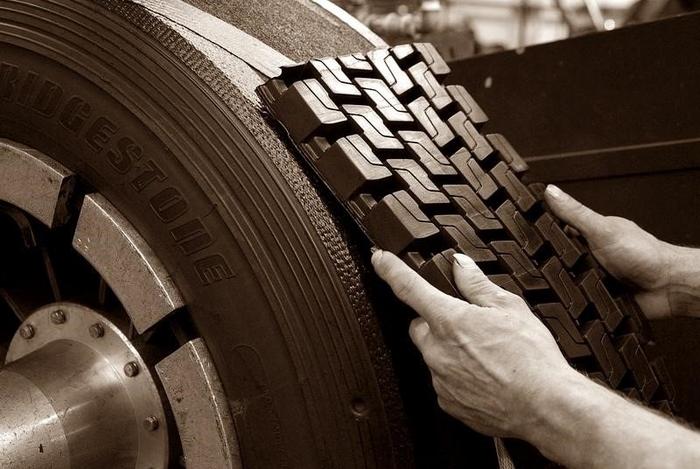
Having navigated through the comparative intricacies of numerous commercial tires, it’s time to delve into an aspect that often goes unnoticed or underappreciated in the trucking industry, which is the utilization of Retread Tires. You might wonder why. Well, let’s set the context with an intriguing possibility: Retread tires could save the trucking industry millions of dollars annually, but how do they perform on the road? Let’s find out.
In my extensive years of experience in the trucking realm, I’ve observed and realized the immense value that retread tires hold. Retread tires have come a long way, and with sustainability driving industry change, I am excited to recount my experiences with retreads that defy the stigma and provide exceptional performance and value. When liaising and transacting with Commercial Tire Suppliers, the transformative potential of retreads has always been a key point of discussion and interest.
The premise behind retread tires is ingenuously simple and practical. Used tire casings are refurbished with new rubber, to create a concoction that is not just environmentally-friendly but also economically appealing. This is particularly advantageous for Truck Tire Brands investing heavily in greener production models as part of their corporate social responsibility.
A common misconception about retreaded tires is that they compromise on performance and safety. However, as a seasoned industry insider, I can confidently rebuff this allegation. My trucks with retreads have handled numerous stress tests immaculately, maintaining poise and grip even under alternating, strenuous conditions of load and terrain. Indeed, retreads have consistently punched above their weight in terms of road endurance, surpassing many new counterparts in some assessments, hence dispelling any apprehensions around their efficacy or reliability.
Naturally, the quality of retreads is dependent on the caliber of the Commercial Tire Suppliers and the technology they adopt for the retreading process. To this end, I have forged relationships with reputed suppliers known for their meticulous attention to detail and stringent quality protocols. Thus, ensuring that the retreads I bag not just cater to my needs but far exceed my expectations.
To wrap up, let me reiterate a fundamental truth of the trucking industry: A good tire should not just tread well, but also tread lightly on our planet and resources. Retread tires, with their blend of economic, performance, and environmental benefits, fit this bill perfectly. Every trucker looking to optimize performance and costs without undermining their sustainable ambition should look no further.
In the next section, we will gear up to explore practical aspects and suggestions related to purchasing 11 22.5 tires, building on the insights garnered so far. So, stay tuned for a ride that combines information, experience, and introspection to help you make an informed choice about your commercial tire needs.
Purchasing Guide: Where to Buy 11 22.5 Tires
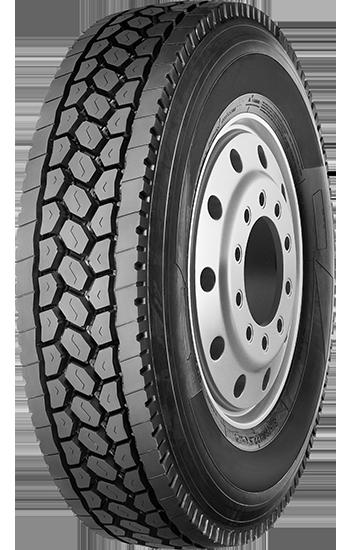
The journey towards finding the ideal set of tires for your truck can be as complex, winding, and intimidating as the most intricate labyrinth. However, armed with the right information and strategy, you can navigate this maze effortlessly, confidently, and successfully.
My first rendezvous with big truck tires was fairly unforgettable due to the array of options and the sheer scale of choice I was confronted with. Knowing very little about 11 inch width and 22.5 inch diameter tires, I felt overwhelmed. What caught me off-guard was not understanding the nuances of commercial tire suppliers and their varied tire prices. Navigating the purchasing process was, indeed, labyrinthian.
And it’s from this initial experience that I offer up a piece of industry wisdom: Buying the best tires for your truck shouldn’t be a maze. I’ve since learned the ins and outs of this industry, enabling me to approach these purchases with more confidence, and now, I want to help you do the same. So, join me as I reveal industry secrets to snatching premium deals on 11 22.5 tires. Get ready to unlock a treasure trove of insights that will empower you to make the best purchasing decision and save money effortlessly at the same time.
Building up your market knowledge is pivotal in making the right purchasing decision. The performance and longevity of your truck rest largely on its tires. Therefore, sourcing them from reputable commercial tire suppliers is essential. These suppliers typically have a wide selection of quality 11 22.5 tires and offer excellent customer service to match. They can guide you through your purchasing process, explaining the pros and cons of different models, and greatly enrich your understanding of what works ideally for your specific truck and driving conditions.
Next, maintaining a vigilant eye for tire prices is equally crucial. Numerous factors, such as the tire’s brand, tread pattern, ply rating, diameter, and width, can affect the price. An 11 inch width and 22.5 inch diameter tire might seem expensive initially. However, such tires tend to offer better handling, improved fuel efficiency and longer tread life – factors that could save you money in the long run. Therefore, quality should never be compromised for cost. Finding the right balance is key.
Allow me to leave you with this final thought. Buying well-priced, quality tires is an investment, an act of ensuring your truck’s longevity and your own safety on the road. So, remember: as you navigate the maze to find your perfect 11 22.5 tires, the light at the end of the tunnel is more than just a new set of tires. It’s peace of mind.
The next section of our journey – ‘Depth Review of Tread Patterns and Ply Ratings‘ – will equip you with even more expert knowledge, prepping you for the dive into the specifics of choosing the right 11 22.5 tire model for your needs. Hang on, as the ride gets even more exciting.
FAQs
What are the major factors to consider when choosing commercial truck tires?
How important is the truck tire size?
What is the significance of 22.5 on commercial truck tires?
Can I replace truck tires on my own?
Conclusion
Bringing a close to our journey through the world of commercial truck tires, my goal has been to empower you with the knowledge to make informed decisions. The vast terrain these tires cover— from Michelin XZE’s enduring tread to Bridgestone R283A’s fuel efficiency, Goodyear G572 1AD’s Fuel Max’s great mileage, and Continental HSL2 Eco Plus’s formidable durability —testify to the versatility and strength of 11 22.5 tires.
In the tire world, knowledge truly is power—and now, it’s time to put that power to the pavement. Let’s recap the game-changers in 11 22.5 tires. With a broad understanding of tread patterns and ply ratings, consideration of tire load capacity, and openness to the benefits of retread tires, your approach to commercial truck tires is well-rounded and informed.
I’ve tread this path so that you can confidently navigate yours, with tires that meet not just an industry-standard, but ‘The Car Coach’ standard. From FAQs to detailed tire reviews and purchase guides, the intention is for you to leverage this information when choosing your ideal set of 11 22.5 tires.
Ultimately, truck tire durability and efficiency hinge on the informed choices you make. I trust this advantageous guide, complemented by your enhanced understanding, steers you toward optimal tire performance that reflects the power of your knowledge and the strength of your truck. So, now armed with your newfound insights, power ahead — it’s your turn to take the wheel and make the right choice on your 11 22.5 tire journey.